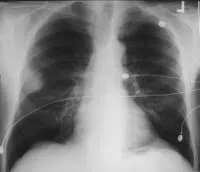Bronchial adenoma is a rare type of cancer that starts in the mucous glands and ducts of the lung airways (bronchi) or windpipe (trachea), and in the salivary glands.
Although the word "adenoma" means a noncancerous tumor, most bronchial adenomas are cancer and can spread to other parts of the body. Yet they often grow slowly and are treatable, so if you have one, keep in mind that they have a good outlook.
Types
These include:
Carcinoid tumors affect hormone-producing cells and nerve cells. They can form in the lungs, or in the stomach and intestines.
Adenoid cystic carcinoma usually starts in the salivary glands in the mouth and throat. It also can affect the trachea, tear glands in the eyes, sweat glands, or a woman's uterus, vulva, or breasts.
Mucoepidermoid carcinoma happens in the salivary glands. Most cancers of this type affect the parotid glands in front of the ears.
Causes
Doctors don’t know the exact cause. Genes may play a role in some forms of this cancer.
People with an inherited disease called multiple endocrine neoplasia type 1 (MEN) are more likely to get lung carcinoid tumors. Having radiation to your head and neck can raise your risk for mucoepidermoid carcinoma.
Symptoms
You may not have any symptoms at first, because carcinoid tumors and some other types of bronchial adenomas grow slowly.
Which kinds of symptoms you eventually get depends on where the cancer is located.
Carcinoid tumor symptoms include:
- Cough, sometimes with blood
- Wheezing
- Shortness of breath
- Chest pain
- Flushing of the face
- Infections such as pneumonia
Adenoid cystic carcinoma symptoms include:
- Lump on the roof of the mouth, under the tongue, or in the bottom of the mouth
- Trouble swallowing
- Hoarse voice
- Numbness in the jaw, roof of the mouth, face, or tongue
- Bump under the jaw or in front of the ear
Mucoepidermoid carcinoma symptoms include:
- Swelling in the glands near your ears, under your lower jaw, or in your mouth
- Numbness or weakness of your face
- Pain in your face
Diagnosis
To diagnose bronchial adenoma, your doctor may give you one or more of these tests:
Biopsyremoves a small piece of tissue. A specialist checks the sample under a microscope to see if it's cancer.
X-rayuses low doses of radiation to make images of structures inside your body. A chest X-ray can look for a tumor in your lungs.
MRI, or magnetic resonance imaging,uses powerful magnets and radio waves to make pictures of organs and structures inside your body. It can show the size of the tumor. You may get a liquid to drink, or into a vein before the test. This contrast dye will help create a clearer picture.
Your doctor might also do other types of scans to look for the tumor and see if it has spread.
Treatment
Which treatment you get depends on your:
- Type and stage of cancer
- Age
- Health
- Preferences
Options include:
Surgery. This is the main treatment for bronchial adenomas. The surgeon will remove the cancer and some of the tissue around it. Lymph nodes around the tumor may also be removed to stop the disease from spreading.
Radiation.This treatment uses high-energy X-rays to kill cancer cells. It can relieve symptoms and help you feel better. You also can get it after surgery to kill any cancer cells left behind.
Most often, you'll get radiation from a machine outside your body. Another option is to have tiny radioactive pellets implanted near the tumor. A few days later, your doctor will take them out.
Radiation can cause side effects such as:
- Fatigue
- Skin redness in the area where you got treatment
- Sore throat and mouth
- Cough
- Shortness of breath
These problems should go away once you stop the treatment.
Chemotherapy. Chemo uses drugs to kill cancer cells all over your body. You get it through a vein (IV) or as a pill. You may get chemo along with other treatments if your cancer has spread. Or, you might get it after surgery to kill any cancer cells left behind.
Possible side effects from chemo include:
- Fatigue
- Nausea and vomiting
- Hair loss
- Loss of appetite
- Diarrhea
- Increased risk of infection
Immunotherapy.This treatment uses medicine to boost your immune system's ability to find and destroy cancer. Immunotherapy can shrink tumors or stop their growth.
Targeted therapy.These treatments look for proteins or genes that are unique to your cancer, and that help it grow. Then it targets those substances to stop the cancer from spreading.
What to Expect
Your treatment might put you into remission. This means your doctors can't find any cancer left in your body and you have no symptoms.
Bronchial adenomas can come back even after they are treated. This is called a recurrence. You'll see your doctor for regular checkups, blood tests, and scans to check for signs of cancer. If your cancer does return, your doctor will try the same treatments, or new treatments to stop its spread.
Support
Treatment for bronchial adenoma can be stressful. It's important to talk openly about your feelings with your doctors, nurses, and the other members of your treatment team. A therapist, psychologist, or counselor can help you get through some of the concerns and emotions you may feel.
You may also want to look for a support group for other people with this condition. It helps to be able to talk with people who know what you’re going through, because they know what it’s like and can relate to you.
X-Ray View

